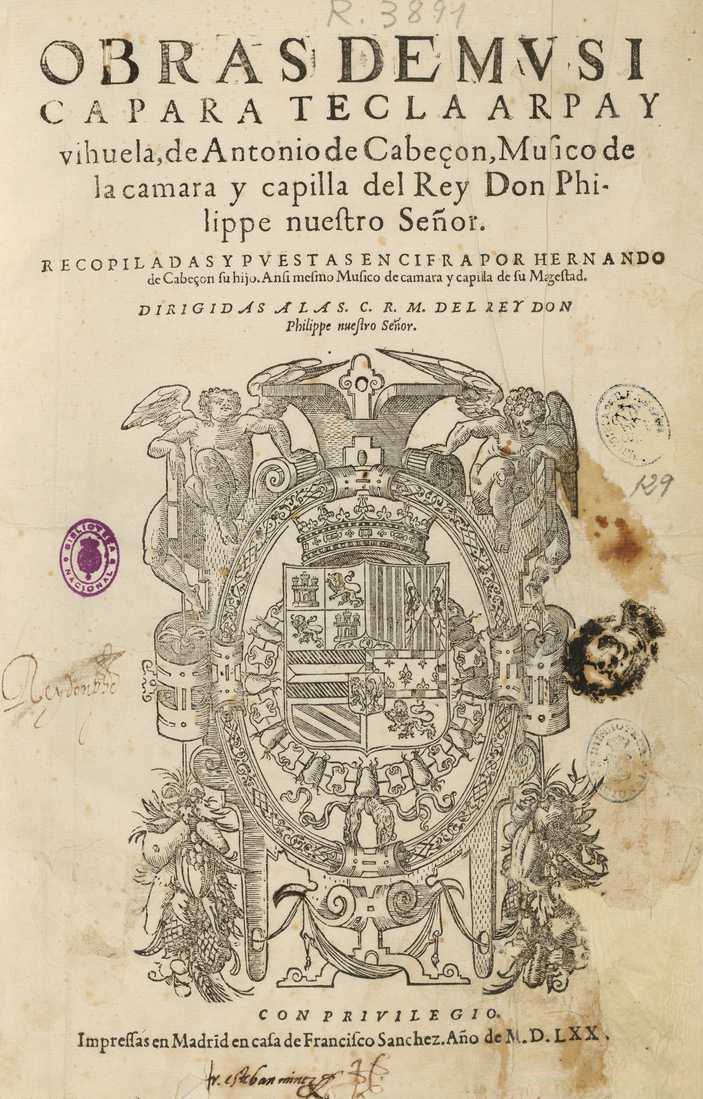Hernando De Cabezón on:
[Wikipedia]
[Google]
[Amazon]
 Hernando de Cabezón, ( baptized 7 September 1541 – 1 October 1602) was a Spanish composer and organist, son of Antonio de Cabezón. Only a few of his works are extant today, and he is chiefly remembered for publishing the bulk of his father's work.
Hernando de Cabezón, ( baptized 7 September 1541 – 1 October 1602) was a Spanish composer and organist, son of Antonio de Cabezón. Only a few of his works are extant today, and he is chiefly remembered for publishing the bulk of his father's work.
 Hernando de Cabezón, ( baptized 7 September 1541 – 1 October 1602) was a Spanish composer and organist, son of Antonio de Cabezón. Only a few of his works are extant today, and he is chiefly remembered for publishing the bulk of his father's work.
Hernando de Cabezón, ( baptized 7 September 1541 – 1 October 1602) was a Spanish composer and organist, son of Antonio de Cabezón. Only a few of his works are extant today, and he is chiefly remembered for publishing the bulk of his father's work.
Biography
He was born inMadrid
Madrid ( , ) is the capital and most populous city of Spain. The city has almost 3.4 million inhabitants and a Madrid metropolitan area, metropolitan area population of approximately 6.7 million. It is the Largest cities of the Europ ...
and probably studied music with his father. From January to December 1559 he was employed at the royal chapel, where his father worked, as a substitute organist. He was appointed organist of the Sigüenza
Sigüenza () is a city in the Serranía de Guadalajara comarca, Province of Guadalajara, Castile-La Mancha, Spain.
History
The site of the ancient ''Segontia'' ('dominating over the valley') of the Celtiberian Arevaci, now called ('old to ...
Cathedral in 1563, and when his father died in 1566, he succeeded him as royal organist. Like his father, he accompanied the court on its travels; this brought him to Portugal, among other places, where he lived in 1580–1581. In 1598, when Philip II of Spain died, Cabezón went on as royal organist with his son Philip III of Spain
Philip III ( es, Felipe III; 14 April 1578 – 31 March 1621) was King of Spain. As Philip II, he was also King of Portugal, Naples, Sicily and Sardinia and Duke of Milan from 1598 until his death in 1621.
A member of the House of Habsburg, Phi ...
. He drafted his will in 1598 and died four years later in Valladolid
Valladolid () is a municipality in Spain and the primary seat of government and de facto capital of the autonomous community of Castile and León. It is also the capital of the province of the same name. It has a population around 300,000 peop ...
.
Only a few of Cabezón's compositions survive. He is chiefly remembered for ''Obras de música para tecla, arpa y vihuela'' (Madrid, 1578), a large collection of music by his father (also including five pieces by Hernando). The ''Obras'' constitute the single most important source for Antonio de Cabezón's work. Hernando's own works include an organ setting of ''Ave maris stella'' and several keyboard intabulation Intabulation, from the Italian word ''intavolatura'', refers to an arrangement of a vocal or ensemble piece for keyboard, lute, or other plucked string instrument, written in tablature.
History
Intabulation was a common practice in 14th–16th c ...
s. All of these pieces are of very high quality, and the intabulations are notable for their rather radical departures from the vocal originals.Apel 1972, pp. 139, 290.
Notes
References
* Apel, Willi. 1972. ''The History of Keyboard Music to 1700''. Translated by Hans Tischler. Indiana University Press. . Originally published as ''Geschichte der Orgel- und Klaviermusik bis 1700'' by Bärenreiter-Verlag, Kassel. *External links
* {{DEFAULTSORT:Cabezon, Hernando Renaissance composers Spanish classical composers 1541 births 1602 deaths Male classical composers Spanish organists Spanish male musicians